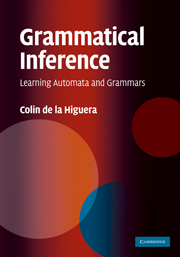2 - The data and some applications
Published online by Cambridge University Press: 05 July 2014
Summary
Errors using inadequate data are much less than those using no data at all.
Charles BabbageIt is a capital mistake to theorise before one has data.
Sir Arthur Conan Doyle, Scandal in BohemiaStrings are a very natural way to encode information: they appear directly with linguistic data (they will then be words or sentences), or with biological data. Computer scientists have for a long time organised information into tree-like data structures. It is reasonable, therefore, that trees arise in a context where the data has been preprocessed. Typical examples are the parse trees of a program or the parse trees of natural language sentences.
Graphs will appear in settings where the information is more complex: images will be encoded into graphs, and first-order logical formulae also require graphs when one wants to associate a semantic.
Grammatical inference is a task where the goal is to learn or infer a grammar (or some device that can generate, recognise or describe strings) for a language and from all sorts of information about this language.
Grammatical inference consists of finding the grammar or automaton for a language of which we are given an indirect presentation through strings, sequences, trees, terms or graphs.
As what characterises grammatical inference is at least as much the data from which we are asked to learn, as the sort of result, we turn to presenting some possible examples of data.
Information
- Type
- Chapter
- Information
- Grammatical InferenceLearning Automata and Grammars, pp. 27 - 42Publisher: Cambridge University PressPrint publication year: 2010
